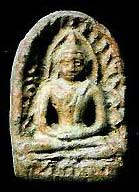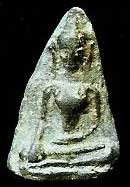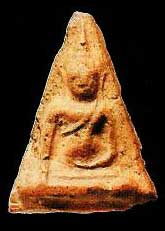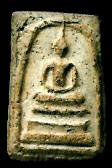BenjaParkee is not a Thai word, it is actually an ancient text derived from Pali, a text that is now used mainly by Theravada Buddhist monks since Buddha's time. Benja means 5 kind or type, Parkee means grouping or set. So BenjaParkee means group or set of 5 different types of amulets.
The idea of grouping 5 different kind of amulets was originally the brainchild of an old collector during the 1950's or earlier, Mr.Triyangpawai who specializes in studying old Buddha amulets. He discovered that the Thai people like to wear a bundle of different amulets around their neck but are often very confused to which grouping would be the best choice. He thought it was time to set a guide and so he decided to aggregate a group of amulets into one set. Together with his fellow collector's friend, they concluded that since Buddha's first batch of student soon after his enlightenment were 5 Arahats whom he met at Deer Park, grouping 5 pieces of amulets to make a set would be the best choice, and hence BenjaParkee would be the most appropriate phrase to be used. Through many discussions, they have finally agreed that the 5 pieces should be Phra Rod 化险为夷佛, Phra Nang Phaya 慈悲佛(皇太后御制), Phra PhongSupang 吉祥佛(素攀), Phra ThungSedthee 富贵佛 and Phra Somdej 頌德/尊者大智佛.
| Phra Rod 化险为夷佛 | |

|
The Thai people regard this particular amulet as Buddha of Escape, meaning the wearer would be able to escape or avoid from all kind of dangers or misfortunes. These are the oldest amulets ever found and they are made of clay, the oldest could be dated to about 1,000 years old. The best and most expensive piece are from Wat Mahawan in Lamphun. |
| Phra ThungSedthee 富贵佛 | |

|
This is sometimes called Buddha of Fortune. It was said that when these amulets were found, an inscription "Poverty will never falls on those who possesses this amulet" was found written in the chedi. It actually comprises of 2 different kinds of amulets, Phra Leela, the walking Buddha in an oblong shape like a jackfruit seed and Phra SoomKor in semi round shape, both from an area called ThungSedthee which means land of millionaires in Khamphaengphet province. Phra Soomkor normally comes in the form of a thumb nail shape, or sometimes in round shape which Thai people called cake. The Buddha image seems to have a mixture of Sukothai style and Sri Lankan style. They are estimated to be made some 600 years ago. Now a days, Phra Soomkor has gained more popularity over Phra Leela as it was smaller and easier to wear than Phra Leela when wearing a full set of BenjaParkee. |
| Phra Phong Suphan 吉祥佛 (素攀) | |
 |
It comes in triangular shape with Buddha seated in "Manvichai" posture. The protruding chest is the most prominent feature of this clay amulet. It has strong "U-thong" style influence. The Thai people believe it could bring good luck and wealth as the chest of the Buddha image is the largest among the rest. Another unique feature of this fine amulet, is that if you turn the amulet around, you will be surprise to find the imprint of thumb that was left by the artist who made it. They are from Chedi of Wat Mahathad in Suphanburi province and estimated to have a history of about 500-600 years too. |
| Phra Nang Phaya 慈悲佛(皇太后御制) | |
 |
This is a pyramid shaped clay amulet of a seated Buddha with slightly oversized head, broad and straight shoulders, seated with right hand touching the ground in victory or in as hand posture of subduing demon. They are from chedis in Pitsanulok Province, the major findings are from Wat Nang Phaya where the name speaks for itself, . It was claimed that they were made by Queen Visutkasatri, wife of King Mahadharmaraja, mother of Great King Naresuan some 500 years ago, as some of the similar amulets were discovered from Wat Rajburana next to Wat Nang Phaya which the Queen has repaired during her reign. The wearers claimed it also provide them with great fortune and metta (compassion, loving kindness), especially for male who wear it. |
| Phra Somdej 頌德/尊者大智佛 | |
 |
Unlike the rest it was made from various powder combined with shell, lime, oil and other special ingredients. Although this is the youngest amulet among the BenjaParkee set, yet it commands the highest price and the most expensive pieces are from Wat Rakang. A beautiful piece in perfect condition could easily reach more than S$ one million. They are very much sought after by politicians, bankers, supreme ranking officials, generals, entrepreneurs and celebrities. Since they are rare, expensive and highly in demand, fake ones have flooded the market.
It is believed that Phra Somdej could bring good luck, confidence, justice, intelligence and success to the wearer. Phra Somdej were made and consecrated by Somdej Phra BuddhaJahn Toh Prommarangsi some 140 years ago, he made them specially for 3 temples, Wat ChaiYo Woraviharn, Wat Rakang Kositaram and Wat Mai Amataros. Phra Somdej Keat ChaiYo was the first to be made. They were made during King Rama IV period, they were either given away or hidden in the chedi of Wat ChaiYo Woraviharn in AngThong. It is believed that they were made as a merit devoted to his mother and grandfather, as his mother's hometown is near Wat Chaiyo and her maiden name was Keat. Chai was his grandfather's name. Hence the amulet is called Phra Somdej KeatChaiYo. Phra Somdej Wat Rakang was made when Somdej Toh became abbot of Wat Rakang during King Rama V period. When Somdej Toh became the abbot of Wat Intarawihan during his final years, he made his last batch of amulets and buried them in a big chedi in Wat Mai Amataros which was during that time only a walking distance from Wat In. This last batch of amulets was called Phra Somdej BangKhunProm as both temples were situated in the area of BangKhunProm . |
